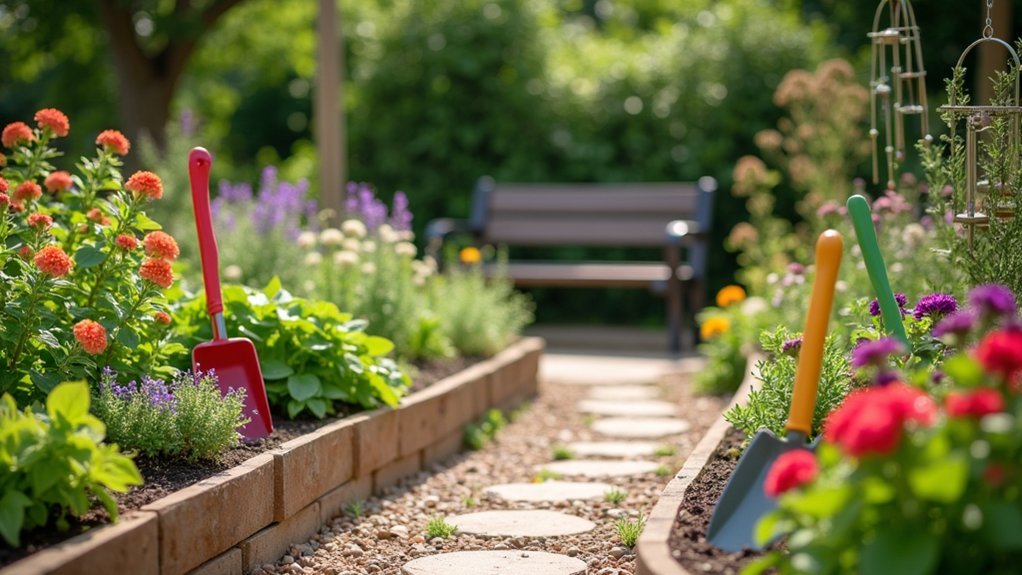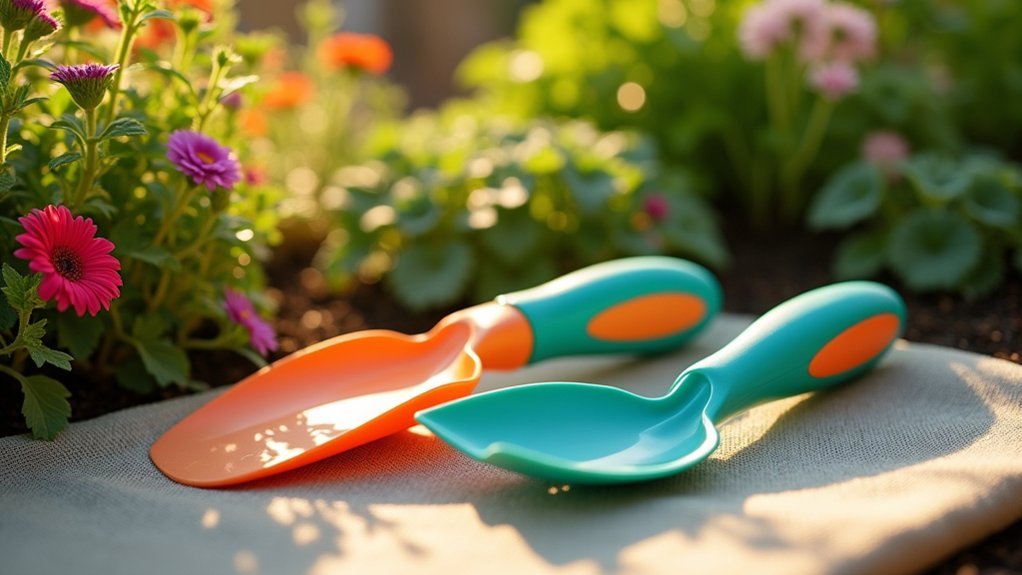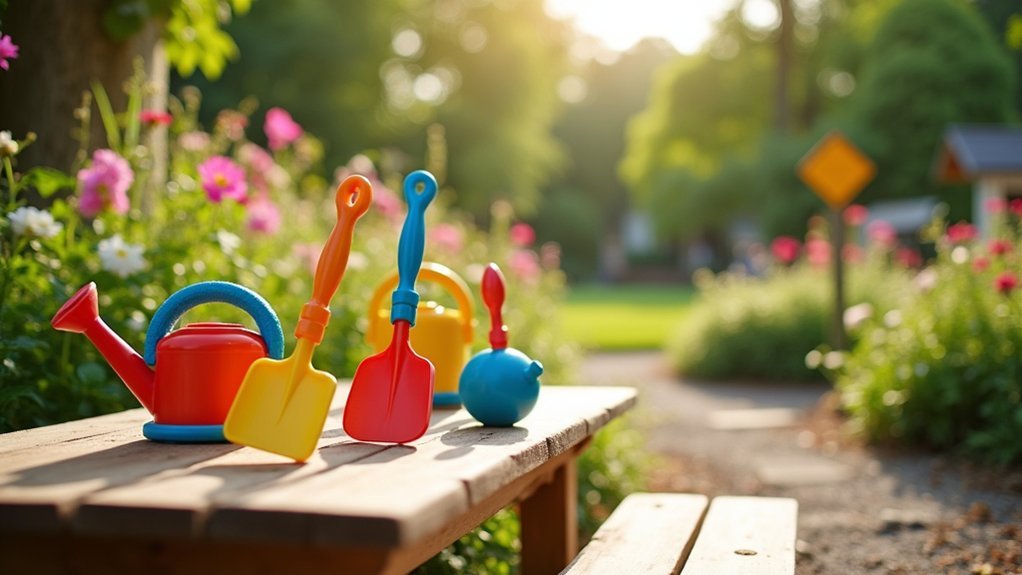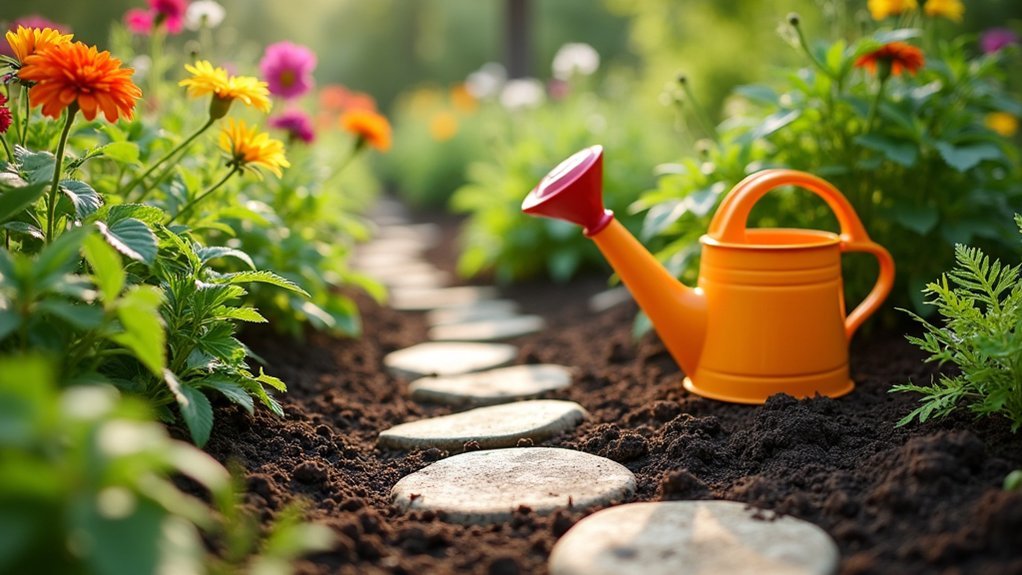Setting up a sensory garden for special needs requires thoughtful tool selection. Choose adaptive options with easy-grip handles, weighted tools for sensory feedback, and lightweight designs for mobility. You’ll need multi-sensory equipment that combines visual, auditory, and tactile elements like textured panels and musical installations. Don’t forget safety essentials: proper storage, non-slip pathways, and protective gear. The right seasonal tools will guarantee your therapeutic garden remains accessible and engaging year-round.
Essential Adaptive Tools for Sensory Garden Access

While creating inclusive garden spaces requires thoughtful planning, the right adaptive tools make all the difference for special needs gardeners.
Start with specialized hand tools featuring easy-grip handles that accommodate limited hand strength. These adapted implements often include weighted trowels and rakes that provide calming sensory feedback during use.
Adaptive garden tools with cushioned grips empower those with dexterity challenges while providing therapeutic sensory input.
You’ll find that tools with adjustable handles serve multiple users with different reach requirements. Using tools with high contrast colors can significantly benefit students with low vision by making them easier to locate and distinguish from the surrounding environment.
For plant identification, invest in tactile markers with raised lettering or symbols that enable recognition through touch. These simple additions transform gardening from a potentially frustrating experience into an accessible activity.
Don’t overlook communication supports like visual aids and tactile communication boards that help non-verbal gardeners express preferences and understand instructions while engaging with plants and materials in your sensory garden.
Selecting Equipment for Diverse Sensory Needs
Because sensory needs vary dramatically among individuals, selecting the right equipment requires a thoughtful, personalized approach.
Consider vestibular input through Unity Basket Swings, spinners, and balance equipment that help develop coordination while providing necessary movement experiences.
For tactile engagement, incorporate textured panels, sensory mazes, and sand play areas.
Children with auditory needs benefit from musical instruments, chimes, and interactive sound stations that let them explore different sounds.
Don’t overlook visual stimulation through colorful panels, mirrors, and LED installations that provide dynamic visual experiences.
For olfactory stimulation, herb gardens and scented play areas offer aromatic exploration opportunities.
When selecting equipment, focus on creating a balanced environment that addresses multiple sensory systems while remaining adaptable to individual preferences and sensitivities. Quality outdoor sensory equipment transforms therapeutic playgrounds into spaces that support both physical and cognitive development.
Ergonomic Gardening Tools for Limited Mobility

Ergonomic gardening tools represent a significant advancement for individuals with limited mobility who wish to engage with sensory gardens. These specialized tools reduce strain on hands, wrists, and joints, making gardening accessible for those with arthritis or strength limitations.
Look for long-handled tools that minimize bending and lightweight options that ease transportation around your garden. Adaptive pruning shears require less hand strength, while ergonomic trowels improve wrist range of motion during planting tasks. When selecting gardening equipment, ensure tools are kept sharp and properly maintained to increase efficiency and reduce the physical effort required for cutting or digging.
For wheelchair users, consider tools specifically designed for seated gardening alongside accessible raised beds.
Don’t overlook supportive accessories like garden kneeler seats for knee and back pain, or swivel seat scooters if walking is difficult. Grabber tools extend your reach without straining, allowing you to tend to plants without excessive bending or stretching.
Creating Multi-Sensory Stations With Specialized Equipment
Multi-sensory stations require thoughtful equipment selection that addresses various sensory needs through specialized tools.
You’ll want to choose equipment that offers diverse sensory input—combining visual, auditory, and tactile elements while ensuring accessibility for all users.
Create designated tool stations with adaptive gardening implements that allow participants to engage with nature regardless of their physical or cognitive abilities.
Musical instrument-inspired installations can transform garden areas into interactive learning spaces that provide auditory stimulation while engaging children in creative expression.
Equipment Selection Essentials
Creating effective multi-sensory stations requires thoughtful selection of specialized equipment that addresses diverse needs while engaging multiple senses simultaneously. When choosing equipment, prioritize versatility and safety while considering how each piece contributes to sensory development.
Combine visual elements like colorful play structures and activity panels with auditory components such as musical instruments and talk tubes. Include tactile opportunities through textured panels and sensory mats, while supporting vestibular development with swings, spinners, and balancing beams.
Don’t overlook olfactory engagement by incorporating fragrant plants and herb gardens. The most effective sensory gardens feature equipment that can be experienced in multiple ways.
For example, a musical wall provides both auditory and tactile stimulation, while illuminated pathways engage both visual senses and support navigation skills. Proprioceptive-focused equipment like climbing structures and overhead ladders helps children develop crucial body positioning awareness and motor planning skills.
Adaptive Tool Stations
Adaptive tool stations represent the practical application of sensory garden principles, transforming theoretical design into tangible, interactive experiences.
You’ll want to position these stations at accessible heights with clear pathways for wheelchair users, incorporating ergonomic tools with textured handles to enhance grip and sensory feedback.
Place your stations near water sources and create sheltered areas to protect users from weather conditions.
Integrate multisensory elements by including plants with distinct scents nearby and tools that provide audio feedback. Selecting specialized equipment with ergonomic designs will significantly reduce strain for gardeners with physical limitations.
Consider incorporating smart gardening tools that offer real-time plant health information.
Don’t overlook safety—regular maintenance guarantees tools remain in good condition, while accessible storage with tactile signage helps all users locate and return equipment independently.
For complete accessibility, supplement physical tools with digital guides and virtual tour options.
Safety Considerations for Special Needs Garden Tools

When designing sensory garden experiences, safety must remain the top priority for participants with special needs. Remove any sharp tools and guarantee proper storage of equipment between sessions. Always provide supervision and establish clear safety protocols. Creating non-slip pathways throughout the garden area is essential for preventing falls and ensuring safe navigation for all participants.
| Safety Element | Why It Matters | Implementation |
|---|---|---|
| Ergonomic Design | Prevents strain and injury | Choose tools with padded, adaptive grips |
| Protective Gear | Guards against hazards | Require gloves, appropriate footwear, and eye protection |
| Environmental Planning | Reduces accidents | Clear pathways and eliminate trip hazards |
| Training Protocol | Builds proper technique | Provide demonstrations with experienced instructors |
Don’t forget to adapt tools with lightweight materials and create comfort zones for foot placement. Weather considerations are also essential—schedule activities during appropriate conditions and have emergency procedures ready for unexpected situations.
Seasonal Maintenance Equipment for Therapeutic Gardens
Therapeutic gardens require specific maintenance tools that change with the seasons to guarantee they remain accessible and stimulating for special needs participants.
In spring, equip yourself with pruners, rakes, and trowels for planting new sensory elements.
Summer demands garden hoses, sprinklers, and lawn mowers to maintain the garden’s liveliness.
When autumn arrives, grab leaf blowers, brooms, and wheelbarrows to clear paths and assure safe accessibility.
Winter protection is crucial—use snow shovels and insulation blankets to safeguard your sensory plants.
Winter’s harshness requires vigilant protection—snow shovels and insulation blankets become your garden’s lifeline during the coldest months.
Don’t forget year-round maintenance tools like pruning shears for regular upkeep of fragrant plants and textured foliage. Consider adding an Abilitations Sensory Garden kit with bright colors to enhance the visual experience for participants.
For water features and sensory elements, invest in pumps, filters, and soft brushes to maintain these therapeutic components throughout the year.
Frequently Asked Questions
How Do Weather Conditions Affect Sensory Garden Tool Selection?
Weather conditions influence your tool selection through durability needs. You’ll want rust-resistant metal tools, weatherproof storage solutions, ergonomic grips that work when wet, and materials that won’t deteriorate in sun or rain.
Can Sensory Gardens Benefit Adults With Dementia?
Yes, sensory gardens can greatly benefit adults with dementia. You’ll notice they reduce agitation, stimulate memory recall, improve mood, and encourage social engagement through their calming environments and diverse sensory experiences.
What Funding Options Exist for Special Needs Garden Equipment?
You’ll find many funding options for special needs garden equipment through government grants like CDBG, foundation support from organizations like KaBOOM!, corporate sponsorships from Lowe’s, and disability-specific organizations such as Autism Speaks.
How Do I Sanitize Shared Sensory Garden Tools Properly?
Clean tools first by removing all soil with a damp cloth. Soak them in a 10% bleach solution for 30 minutes, then rinse thoroughly. You’ll need to wear gloves and let tools air dry before storing them.
When Should Children Transition From Adaptive to Standard Gardening Tools?
Shift your child from adaptive to standard gardening tools when they demonstrate sufficient strength, dexterity, and safety awareness—typically around ages 8-10. You’ll know they’re ready when they show consistent responsibility and interest.
In Summary
You’ll find that the right sensory garden tools transform accessibility and enjoyment for individuals with special needs. By investing in adaptive equipment that addresses diverse sensory profiles and mobility challenges, you’re creating opportunities for meaningful engagement with nature. Remember to prioritize safety features and maintain your garden tools seasonally. With thoughtful setup and appropriate equipment, you’re nurturing a space where everyone can experience the therapeutic benefits of gardening.





Leave a Reply